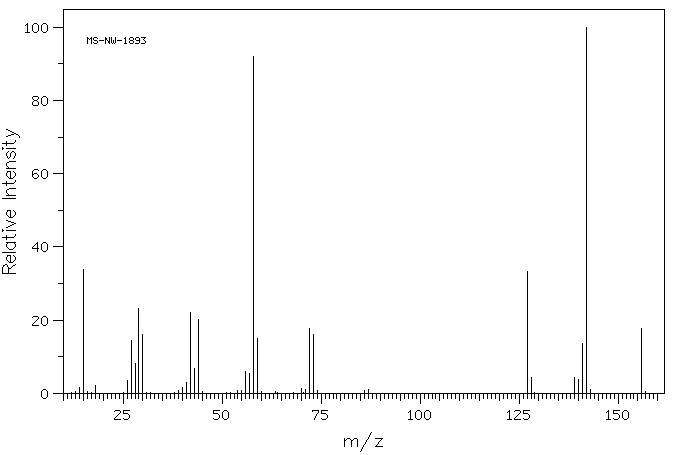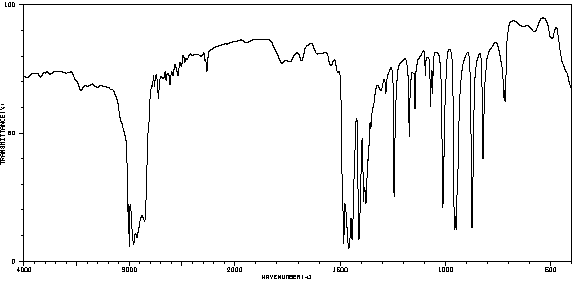乙基三甲基碘化铵 | 51-93-4
中文名称
乙基三甲基碘化铵
中文别名
乙基三甲基碘化胺
英文名称
ethyltrimethylammonium iodide
英文别名
N,N,N-trimethylethanaminium iodide;trimethylethylammonium iodide;ethyl-trimethyl-ammonium; iodide;Aethyl-trimethyl-ammonium; Jodid;Ethyl-trimethyl-ammonium iodid;ethyl(trimethyl)azanium;iodide
CAS
51-93-4
化学式
C5H14N*I
mdl
——
分子量
215.077
InChiKey
ZPEBBUBSCOELHI-UHFFFAOYSA-M
BEILSTEIN
——
EINECS
——
-
物化性质
-
计算性质
-
ADMET
-
安全信息
-
SDS
-
制备方法与用途
-
上下游信息
-
文献信息
-
表征谱图
-
同类化合物
-
相关功能分类
-
相关结构分类
物化性质
-
熔点:245 °C (decomp)
-
溶解度:H2O:50 mg/mL,澄清,无色
计算性质
-
辛醇/水分配系数(LogP):-2.28
-
重原子数:7
-
可旋转键数:1
-
环数:0.0
-
sp3杂化的碳原子比例:1.0
-
拓扑面积:0
-
氢给体数:0
-
氢受体数:1
安全信息
-
危险品标志:Xi
-
危险类别码:R36/37/38
-
WGK Germany:3
-
RTECS号:BQ6045000
-
海关编码:2923900090
-
危险标志:GHS07
-
危险性描述:H315,H319,H335
-
危险性防范说明:P261,P305 + P351 + P338
-
储存条件:避免光照
SDS
模块 1. 化学品
1.1 产品标识符
: 乙基三甲基碘化铵
产品名称
1.2 鉴别的其他方法
无数据资料
1.3 有关的确定了的物质或混合物的用途和建议不适合的用途
仅用于研发。不作为药品、家庭或其它用途。
模块 2. 危险性概述
2.1 GHS-分类
皮肤刺激 (类别 2)
眼睛刺激 (类别 2A)
特异性靶器官系统毒性(一次接触) (类别 3)
2.2 GHS 标记要素,包括预防性的陈述
象形图
警示词 警告
危险申明
H315 造成皮肤刺激。
H319 造成严重眼刺激。
H335 可能引起呼吸道刺激。
警告申明
预防措施
P261 避免吸入粉尘/烟/气体/烟雾/蒸气/喷雾.
P264 操作后彻底清洁皮肤。
P271 只能在室外或通风良好之处使用。
P280 穿戴防护手套/ 眼保护罩/ 面部保护罩。
事故响应
P302 + P352 如果皮肤接触:用大量肥皂和水清洗。
P304 + P340 如吸入: 将患者移到新鲜空气处休息,并保持呼吸舒畅的姿势。
P305 + P351 + P338 如与眼睛接触,用水缓慢温和地冲洗几分钟。如戴隐形眼镜并可方便地取
出,取出隐形眼镜,然后继续冲洗.
P312 如感觉不适,呼救中毒控制中心或医生.
P321 具体处置(见本标签上提供的急救指导)。
P332 + P313 如觉皮肤刺激:求医/就诊。
P337 + P313 如仍觉眼睛刺激:求医/就诊。
P362 脱掉沾污的衣服,清洗后方可再用。
安全储存
P403 + P233 存放于通风良的地方。 保持容器密闭。
P405 存放处须加锁。
废弃处置
P501 将内容物/ 容器处理到得到批准的废物处理厂。
2.3 其它危害物 - 无
模块 3. 成分/组成信息
3.1 物 质
: C5H14IN
分子式
: 215.08 g/mol
分子量
组分 浓度或浓度范围
Ethyltrimethylammonium iodide
<=100%
化学文摘登记号(CAS 51-93-4
No.) 200-131-5
EC-编号
模块 4. 急救措施
4.1 必要的急救措施描述
一般的建议
请教医生。 向到现场的医生出示此安全技术说明书。
吸入
如果吸入,请将患者移到新鲜空气处。 如呼吸停止,进行人工呼吸。 请教医生。
皮肤接触
用肥皂和大量的水冲洗。 请教医生。
眼睛接触
用大量水彻底冲洗至少15分钟并请教医生。
食入
切勿给失去知觉者通过口喂任何东西。 用水漱口。 请教医生。
4.2 主要症状和影响,急性和迟发效应
据我们所知,此化学,物理和毒性性质尚未经完整的研究。
4.3 及时的医疗处理和所需的特殊处理的说明和指示
无数据资料
模块 5. 消防措施
5.1 灭火介质
灭火方法及灭火剂
用水雾,抗乙醇泡沫,干粉或二氧化碳灭火。
5.2 源于此物质或混合物的特别的危害
碳氧化物, 氮氧化物, 碘化氢
5.3 给消防员的建议
如必要的话,戴自给式呼吸器去救火。
5.4 进一步信息
无数据资料
模块 6. 泄露应急处理
6.1 作业人员防护措施、防护装备和应急处置程序
使用个人防护用品。 避免粉尘生成。 避免吸入蒸气、烟雾或气体。 保证充分的通风。
人员疏散到安全区域。 避免吸入粉尘。
6.2 环境保护措施
不要让产品进入下水道。
6.3 泄漏化学品的收容、清除方法及所使用的处置材料
收集和处置时不要产生粉尘。 扫掉和铲掉。 放入合适的封闭的容器中待处理。
6.4 参考其他部分
丢弃处理请参阅第13节。
模块 7. 操作处置与储存
7.1 安全操作的注意事项
避免接触皮肤和眼睛。 避免形成粉尘和气溶胶。
在有粉尘生成的地方,提供合适的排风设备。一般性的防火保护措施。
7.2 安全储存的条件,包括任何不兼容性
贮存在阴凉处。 使容器保持密闭,储存在干燥通风处。
7.3 特定用途
无数据资料
模块 8. 接触控制和个体防护
8.1 容许浓度
最高容许浓度
没有已知的国家规定的暴露极限。
8.2 暴露控制
适当的技术控制
根据良好的工业卫生和安全规范进行操作。 休息前和工作结束时洗手。
个体防护设备
眼/面保护
带有防护边罩的安全眼镜符合 EN166要求请使用经官方标准如NIOSH (美国) 或 EN 166(欧盟)
检测与批准的设备防护眼部。
皮肤保护
戴手套取 手套在使用前必须受检查。
请使用合适的方法脱除手套(不要接触手套外部表面),避免任何皮肤部位接触此产品.
使用后请将被污染过的手套根据相关法律法规和有效的实验室规章程序谨慎处理. 请清洗并吹干双手
所选择的保护手套必须符合EU的89/686/EEC规定和从它衍生出来的EN 376标准。
完全接触
物料: 丁腈橡胶
最小的层厚度 0.11 mm
溶剂渗透时间: 480 min
测试过的物质Dermatril® (KCL 740 / Z677272, 规格 M)
飞溅保护
物料: 丁腈橡胶
最小的层厚度 0.11 mm
溶剂渗透时间: 480 min
测试过的物质Dermatril® (KCL 740 / Z677272, 规格 M)
, 测试方法 EN374
如果以溶剂形式应用或与其它物质混合应用,或在不同于EN
374规定的条件下应用,请与EC批准的手套的供应商联系。
这个推荐只是建议性的,并且务必让熟悉我们客户计划使用的特定情况的工业卫生学专家评估确认才可.
这不应该解释为在提供对任何特定使用情况方法的批准.
身体保护
防渗透的衣服, 防护设备的类型必须根据特定工作场所中的危险物的浓度和数量来选择。
呼吸系统防护
如须暴露于有害环境中,请使用P95型(美国)或P1型(欧盟 英国
143)防微粒呼吸器。如需更高级别防护,请使用OV/AG/P99型(美国)或ABEK-P2型 (欧盟 英国 143)
防毒罐。
呼吸器使用经过测试并通过政府标准如NIOSH(US)或CEN(EU)的呼吸器和零件。
模块 9. 理化特性
9.1 基本的理化特性的信息
a) 外观与性状
形状: 结晶
颜色: 白色
b) 气味
无数据资料
c) 气味阈值
无数据资料
d) pH值
无数据资料
e) 熔点/凝固点
无数据资料
f) 沸点、初沸点和沸程
无数据资料
g) 闪点
无数据资料
h) 蒸发速率
无数据资料
i) 易燃性(固体,气体)
无数据资料
j) 高的/低的燃烧性或爆炸性限度 无数据资料
k) 蒸气压
无数据资料
l) 蒸汽密度
无数据资料
m) 密度/相对密度
无数据资料
n) 水溶性
50 g/l
o) n-辛醇/水分配系数
无数据资料
p) 自燃温度
无数据资料
q) 分解温度
无数据资料
r) 粘度
无数据资料
模块 10. 稳定性和反应活性
10.1 反应性
无数据资料
10.2 稳定性
无数据资料
10.3 危险反应
无数据资料
10.4 应避免的条件
无数据资料
10.5 不相容的物质
强氧化剂
10.6 危险的分解产物
其它分解产物 - 无数据资料
模块 11. 毒理学资料
11.1 毒理学影响的信息
急性毒性
半数致死剂量 (LD50) 腹膜内的 - 小鼠 - 40 mg/kg
皮肤刺激或腐蚀
无数据资料
眼睛刺激或腐蚀
无数据资料
呼吸道或皮肤过敏
无数据资料
生殖细胞致突变性
无数据资料
致癌性
IARC:
此产品中没有大于或等于 0。1%含量的组分被 IARC鉴别为可能的或肯定的人类致癌物。
生殖毒性
无数据资料
特异性靶器官系统毒性(一次接触)
吸入 - 可能引起呼吸道刺激。
特异性靶器官系统毒性(反复接触)
无数据资料
吸入危险
无数据资料
潜在的健康影响
吸入 吸入可能有害。 引起呼吸道刺激。
摄入 如服入是有害的。
皮肤 通过皮肤吸收可能有害。 造成皮肤刺激。
眼睛 造成严重眼刺激。
接触后的征兆和症状
据我们所知,此化学,物理和毒性性质尚未经完整的研究。
附加说明
化学物质毒性作用登记: BQ6045000
模块 12. 生态学资料
12.1 生态毒性
无数据资料
12.2 持久性和降解性
无数据资料
12.3 潜在的生物累积性
无数据资料
12.4 土壤中的迁移性
无数据资料
12.5 PBT 和 vPvB的结果评价
无数据资料
12.6 其它不良影响
无数据资料
模块 13. 废弃处置
13.1 废物处理方法
产品
将剩余的和不可回收的溶液交给有许可证的公司处理。
联系专业的拥有废弃物处理执照的机构来处理此物质。
与易燃溶剂相溶或者相混合,在备有燃烧后处理和洗刷作用的化学焚化炉中燃烧
受污染的容器和包装
按未用产品处置。
模块 14. 运输信息
14.1 联合国危险货物编号
欧洲陆运危规: - 国际海运危规: - 国际空运危规: -
14.2 联合国运输名称
欧洲陆运危规: 非危险货物
国际海运危规: 非危险货物
国际空运危规: 非危险货物
14.3 运输危险类别
欧洲陆运危规: - 国际海运危规: - 国际空运危规: -
14.4 包裹组
欧洲陆运危规: - 国际海运危规: - 国际空运危规: -
14.5 环境危险
欧洲陆运危规: 否 国际海运危规 国际空运危规: 否
海洋污染物(是/否): 否
14.6 对使用者的特别提醒
无数据资料
模块 15 - 法规信息
N/A
模块16 - 其他信息
N/A
反应信息
-
作为反应物:描述:参考文献:名称:环保的乙酰胆碱-羧酸盐生物离子液体,可在低温下使用环境CO 2进行可控的N-甲基化和N-甲酰化摘要:催化固定CO 2以生产有价值的精细化学物质对于在环境中建立绿色和可持续的过量碳循环具有重要意义。在此,简单地合成了一系列具有不同阳离子和阴离子的无毒,可生物降解和可回收的乙酰胆碱-羧酸盐生物离子液体,以大气中的CO 2为碳源,苯基硅烷为氢供体来生产甲酰胺和甲胺。通过改变在溶剂或无溶剂条件下的反应温度来调节对产物的选择性。在50°C的乙腈中获得N-甲胺(约96%收率),而N-甲酰胺(约50%收率)。在30°C下无需使用溶剂即可获得99%的收率。已建立的生物离子液体催化系统发现了在底物中的广泛适用性,并具有扩大规模以生产克级产品的巨大潜力。所开发的催化体系相当稳定,很容易重用而不会明显降低反应性,这可能是由于阳离子和阴离子之间的强静电相互作用所致。实验和计算结果的结合清楚地阐明了反应机理:由生物IL活化的PhSiH 3有利于CO 2的氢硅烷化形成甲硅烷基甲酸酯,然后与胺反应生成N-甲酰胺,而一DOI:10.1039/c8gc03549k
-
作为产物:描述:参考文献:名称:Collie; Schryver, Journal of the Chemical Society, 1890, vol. 57, p. 774摘要:DOI:
-
作为试剂:描述:6-amino-2,2,7-trifluoro-4H-benzo-[1,4]-oxazin-3-one 、 3-氯丙炔 在 乙基三甲基碘化铵 、 potassium carbonate 作用下, 以 乙酸乙酯 、 甲苯 为溶剂, 反应 10.0h, 以95.9%的产率得到6-amino-2,2,7-trifluoro-4-prop-2-ynyl-4H-benzo[1,4]oxazin-3-one参考文献:名称:PROCESS FOR MANUFACTURING TRIAZINON-BENZOXAZINONES摘要:本发明涉及一种制备式(I)的三嗪基苯并噁唑酮的方法,通过将式(II)的氨基苯并噁唑酮与1,1'-碳酰二咪唑(CDI)和式(III)的(硫)脲化合物反应而得;其中变量根据描述中的定义确定。公开号:US20140316131A1
文献信息
-
Carbonylation of quaternary ammonium salts to tertiary amides using NaCo(CO)4 catalyst作者:Yizhu Lei、Rui Zhang、Qing Wu、Hui Mei、Bo Xiao、Guangxing LiDOI:10.1016/j.molcata.2013.10.014日期:2014.1the catalytic carbonylation of quaternary ammonium salts under anhydrous condition. Quaternary ammonium salts, a kind of versatile reagents that were widely used in organometallic chemistry, can be carbonylated to tertiary amides by an in situ prepared NaCo(CO)4 catalyst. It was found that the counterions (Cl−, Br−, I−, OTf−) in the quaternary ammonium salts played a significant role in the reaction我们在这里报道了在无水条件下季铵盐的催化羰基化反应。季铵盐是一种广泛用于有机金属化学的通用试剂,可通过原位制备的NaCo(CO)4催化剂羰基化为叔酰胺。结果发现,该抗衡离子(CL - ,溴- ,我- ,光学传递函数- )在季铵盐中的反应中发挥了作用显著和碘化四甲基铵可以给的高产率(96%)Ñ,Ñ-仅含0.5摩尔%钴催化剂的-二甲基乙酰胺(DMAc)。在最佳条件下,其他几种季铵碘化物也以中等至极好的收率被羰基化为相应的叔酰胺。显然,这些结果也使我们特别理解,Me 4 NI和其他季铵盐在羰基化反应中可能被羰基化为叔酰胺,在大多数情况下它们被用作促进剂或溶剂。考虑到高活性和中等至优异的选择性,该方法可能是合成某些叔酰胺的潜在方法。此外,详细讨论了CN键的裂解机理和可能的催化中间体。
-
A New Type of Two-Dimensional Organic Conductors: Alkylammonium Bis[1,2,5]thiadiazolotetracyanoquinodimethanides作者:Takanori Suzuki、Chizuko Kabuto、Yoshiro Yamashita、Toshio Mukai、Tsutomu Miyashi、Gunzi SaitoDOI:10.1246/bcsj.61.483日期:1988.2Anion radical salts of bis[1,2,5]thiadiazolotetracyanoquinodimethan (BTDA) containing forty kinds of alkylammonium ions were prepared whose molar ratios are unique for each cation and changed from 1:1 (2A–2L) to 2:3 (2M–2Z), 1:2 (2a–2m), and 2:5 (2n) with elongation of the side chains. The electrical conductivities of the salts are largely affected by the molar ratio and the spatial requirement of制备了含有四十种烷基铵离子的双[1,2,5]噻二唑并四氰基醌二甲烷(BTDA)的阴离子自由基盐,其摩尔比对于每个阳离子都是唯一的,并且从1:1(2A-2L)变为2:3(2M-)。 2Z)、1:2 (2a–2m) 和 2:5 (2n),侧链伸长。盐的电导率很大程度上受摩尔比和阳离子空间要求的影响(2a 的 ρRT 3.1 Ω cm 和 2L 的 4.2×106 Ω cm),并且一些盐表现出高电导率(ρRT 3.1-8.3 Ω cm 用于 2a–2e),具有小各向异性(ρ⁄⁄ 1.7 Ω cm,ρ⊥ 21.6 Ω cm,用于 2g 的单晶)。三种盐(2A、2M 和 2g)显示出电导率的半导体温度依赖性,活化能为 0.12-0.20 eV。三种盐类(2A、2g、和 2m)表明二维网络是由 BTDA 阴离子自由基的 S-N≡C 相互作用(3.12-3.33 A)形成的。显示出更高电导率的 2A 和
-
New Ionic Plastic Crystals of NR<sub>4</sub>BEt<sub>3</sub>Me (R = Me and Et) and NR<i><sub>x</sub></i>R′<sub>4−</sub><i><sub>x</sub></i>BEt<sub>3</sub>Me (R = Et, R′ = Me and Pr, <i>x</i> = 1–3) in a New Class of Plastic Crystals作者:Tomoyuki Hayasaki、Satoru Hirakawa、Hisashi HondaDOI:10.1246/bcsj.20130040日期:2013.8.15New ionic plastic crystals of NR4BEt3Me (R = Me and Et) and NRxR′4−xBEt3Me (R = Et, R′ = Me and Pr, x = 1–3) were formed in a new region of plastic crystal. In this area, globular cations and anions are assembled by weak interactions. On the basis of our results of 1H and 13C NMR spectra and electrical conductivity measurements, we could conclude that isotropic reorientation and self-diffusion of globular cations and anions were detected in the crystal. X-ray diffraction (XRD) lines observed in RxR′4−xBEt3Me (R = Et, R′ = Me, x = 0–4) revealed a CsCl-type cubic crystal structure. Additionally, DSC spectra revealed that this new class of plastic crystals displays low phase-transition temperatures in the plastic phase and have high melting points. The former tendency is frequently detected in molecular plastic crystals while the latter is often found in ionic plastic crystals.新型的NR4BEt3Me (R = Me和Et)和NRxR′4−xBEt3Me (R = Et, R′ = Me和Pr, x = 1–3)离子塑料晶体在新区域的塑料晶体中形成。在这一区域,球状阳离子和阴离子通过弱相互作用组装在一起。根据我们对1H和13C NMR谱图及电导率测量的结果,可以得出结论:在晶体中检测到了球状阳离子和阴离子的各向同性重定向和自扩散。X射线衍射(XRD)线在RxR′4−xBEt3Me (R = Et, R′ = Me, x = 0–4)中揭示了一个CsCl型立方晶体结构。此外,DSC谱图显示这类新型塑料晶体在塑料相中具有较低的相变温度,并且熔点较高。前一种趋势在分子塑料晶体中经常被检测到,而后一种则通常在离子塑料晶体中发现。
-
A microscopic hydrophobicity parameter作者:F. M. Menger、U. V. VenkataramDOI:10.1021/ja00271a029日期:1986.5Le laurate de nitro-4 phenyle dans l'eau forme des agregats dans lesquels les groupes esters s'hydrolysent lentement. Des sels, de formule generale RN(CH 3 ) 3 + X − rompent ou detruisent les agregats. Les groupes esters sont alors deproteges et les vitesses d'hydrolyse observees croissent. L'importance de l'accroissement de vitesse depend de RLe laurate de nitro-4 phenyle dans l'eau forme des agregats dans lesquels les groupesesters s'hydrolysent lentement。Desels, deformule generale RN(CH 3 ) 3 + X − rompent ou detruisent les agregats。Les groupesesters sont alors deproteges et les vitesses d'hydrolyse 观察羊角面包。L'importance de l'accroissement de vitesse depends de R
-
Plasticity in [(R <sub> 4– <i>x</i> </sub> R <sup>1</sup> <i> <sub>x</sub> </i> ) <sub>4</sub> N] <sub>4</sub> [Cu <sub>4</sub> {S <sub>2</sub> C <sub>2</sub> (CN) <sub>2</sub> } <sub>4</sub> ] ( <i>x</i> = 0–4) is Molded by a Guest Cation on an Elastic Anionic Host作者:Biplab K. Maiti、Kuntal Pal、Sabyasachi SarkarDOI:10.1002/ejic.200800094日期:2008.5r host-guest assemblies [Me4N]4[Cu4(mnt)4] (1), [Me3EtN]4[Cu4(mnt)4] (2), [Me2Et2N]4[Cu4(mnt)4] (3), [MeEt3N]4[Cu4(mnt)4] (4) and [Et4N]4[Cu4(mnt)4] (5), which have been characterized by X-ray structural studies in the solid state. The host cavity shrinks and expands, with varying Cu···Cu separations ranging from 2.754 to 3.952 A, to accommodate the relevant guest ion during the crystallization process弹性阴离子 [Cu4(mnt)4]4– mnt =maleonitriledithiolato, [S2C2(CN)2]2–} 作为一系列客体阳离子 [(R4–xR1x)4N]+ (R = Et , R1 = Me; x = 0–4) 形成复合物 [(R4–xR1x)4N]4[Cu4S2C2(CN)2}4]。存储在阳离子中的分子结构设计信息通过氢键模塑到弹性阴离子主体框架上,以创建塑料超分子实体。CuCl 与 Na2(mnt) 以 1:1 的金属/配体比反应,然后与各自的阳离子相互作用,得到依赖于阳离子的四核主客体组装体 [Me4N]4[Cu4(mnt)4] (1) , [Me3EtN]4[Cu4(mnt)4] (2), [Me2Et2N]4[Cu4(mnt)4] (3), [MeEt3N]4[Cu4(mnt)4] (4) 和 [Et4N]4 [Cu4(mnt)4] (5),已通过固态的
表征谱图
-
氢谱1HNMR
-
质谱MS
-
碳谱13CNMR
-
红外IR
-
拉曼Raman
-
峰位数据
-
峰位匹配
-
表征信息
同类化合物
(乙腈)二氯镍(II)
(R)-(-)-α-甲基组胺二氢溴化物
(N-(2-甲基丙-2-烯-1-基)乙烷-1,2-二胺)
(4-(苄氧基)-2-(哌啶-1-基)吡啶咪丁-5-基)硼酸
(11-巯基十一烷基)-,,-三甲基溴化铵
鼠立死
鹿花菌素
鲸蜡醇硫酸酯DEA盐
鲸蜡硬脂基二甲基氯化铵
鲸蜡基胺氢氟酸盐
鲸蜡基二甲胺盐酸盐
高苯丙氨醇
高箱鲀毒素
高氯酸5-(二甲氨基)-1-({(E)-[4-(二甲氨基)苯基]甲亚基}氨基)-2-甲基吡啶正离子
高氯酸2-氯-1-({(E)-[4-(二甲氨基)苯基]甲亚基}氨基)-6-甲基吡啶正离子
高氯酸2-(丙烯酰基氧基)-N,N,N-三甲基乙铵
马诺地尔
马来酸氢十八烷酯
马来酸噻吗洛尔EP杂质C
马来酸噻吗洛尔
马来酸倍他司汀
顺式环己烷-1,3-二胺盐酸盐
顺式氯化锆二乙腈
顺式吡咯烷-3,4-二醇盐酸盐
顺式双(3-甲氧基丙腈)二氯铂(II)
顺式3,4-二氟吡咯烷盐酸盐
顺式1-甲基环丙烷1,2-二腈
顺式-二氯-反式-二乙酸-氨-环己胺合铂
顺式-二抗坏血酸(外消旋-1,2-二氨基环己烷)铂(II)水合物
顺式-N,2-二甲基环己胺
顺式-4-甲氧基-环己胺盐酸盐
顺式-4-环己烯-1.2-二胺
顺式-4-氨基-2,2,2-三氟乙酸环己酯
顺式-3-氨基环丁烷甲腈盐酸盐
顺式-2-羟基甲基-1-甲基-1-环己胺
顺式-2-甲基环己胺
顺式-2-(苯基氨基)环己醇
顺式-2-(苯基氨基)环己醇
顺式-2-(氨基甲基)-1-苯基环丙烷羧酸盐酸盐
顺式-1,3-二氨基环戊烷
顺式-1,2-环戊烷二胺二盐酸盐
顺式-1,2-环戊烷二胺
顺式-1,2-环丁腈
顺式-1,2-双氨甲基环己烷
顺式--N,N'-二甲基-1,2-环己二胺
顺式-(R,S)-1,2-二氨基环己烷铂硫酸盐
顺式-(2-氨基-环戊基)-甲醇
顺-2-戊烯腈
顺-1,3-环己烷二胺
顺-1,3-双(氨甲基)环己烷








